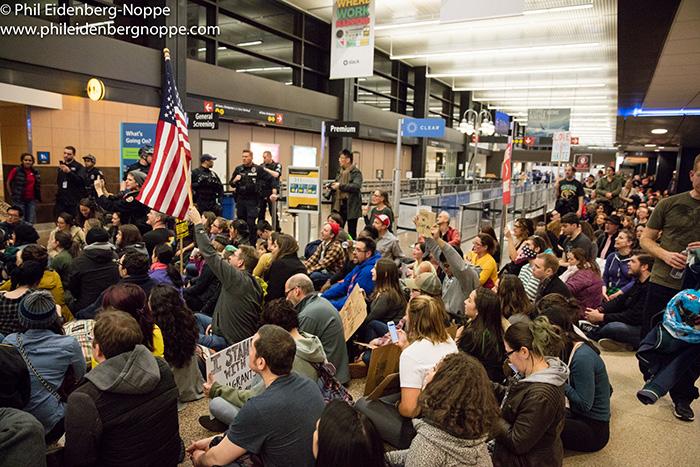Washington versus Trump: Round one begins
Thousands of public officials, attorneys and protestors gathered at Sea-Tac airport to oppose the executive order on immigration
Protesters sit on the floor of the Seattle-Tacoma Airport
Washington state legislators successfully defended Seattle judge’s ruling that put a hold on the Trump Administration’s travel ban.
Washington state legislators met with Department of Justice representatives in a rare over-the-phone appeals court hearing Feb. 7 to discuss the suspension of Donald Trump’s immigration order.
The call was broadcast live across news networks, newspaper websites and social media, amassing a major audience. The YouTube livestream alone featured over 130,000 live listeners.
The results of this hearing resolved to a 4-4 split, temporarily sustaining the lift of the ban and requiring the Trump administration to take further action.
On Jan. 27, President Donald Trump issued the executive order titled “Protecting the Nation from Foreign Terrorist Entry into the United States,” which put into effect a 90-day travel ban from seven Muslim-majority countries, suspended the Refugee Admissions Program for 120 days and banned the admission of Syrian refugees indefinitely.
These changes began immediately. Within hours of the policy being instated, hundreds of foreigners arriving in the United States became detained, and many more were forced onto return flights.
The next day, almost 2,000 protesters and public officials flooded the Seattle-Tacoma International Airport to speak out against the prejudice of the travel ban and to demand the release of those who were being detained.
According to Seattle’s KUOW-FM, several civil liberties attorneys were running around providing free legal services, as many as 13 people were detained on arrival at Sea-Tac and several more had been placed on return flights before help arrived.
Americans are extremely divided on this issue. Many citizens agree with this blunt, blanket approach to immigration reform.
This “better safe than sorry” model reflects the same values Trump carried on the campaign trail, specifically his most controversial issues regarding the national Muslim registry and temporarily banning Muslim immigration to the United States.
In the midst of this chaos and controversy, Washington State government officials were planning to strike back against the President’s order.
Gov. Jay Inslee, along with several other elected Washington state officials, held a news conference at the airport to publicly denounce Trump’s executive order on account of its unconstitutional nature.
“The manifest and unjustifiable chaos and cruelty caused by President Trump’s executive order is now on full display here at Sea-Tac Airport,” Gov. Inslee said.
During the protest, Port of Seattle Commissioner Courtney Gregoire met with Ibado Ahmed, a refugee who has lived in Seattle for 12 years and was waiting for her husband to return from Somalia from Vienna. Federal customs agents had detained Ahmed’s husband as soon as he arrived.
Commissioner Gregoire told the Seattle Times in an interview that she had tried to arrange for Ahmed’s husband to speak with an attorney, but by the time she arrived to the scene he had already been deported.
Gov. Inslee spoke on Ahmed’s plight: “We have a family here today, a citizen of the United States, the Donald Trump administration allowed her husband to get on a plane in Vienna, waiting to get into the arms of his wife, but didn’t let him go the six feet across this gate to embrace his wife. … What type of cruel attitude based on demagoguery and fear does that to people? To anybody?”
Scenes like Ahmed’s were being reported all across the country as protests continued across virtually every major airport in the United States. Thousands of people banded together in fear and outrage.
According to a Jan. 31 news briefing at the Customs and Border Protection Agency officials said that 721 people had been denied boarding for the United States after it began enforcing the travel ban.
This was all more than enough motivation for Gov. Inslee to order state legislators to take legal action against Trump’s order.
Attorney General Bob Ferguson led the attack, and within only two days filed a complaint against Trump’s executive order. On Feb. 3 Ferguson successfully achieved a ruling from U.S. District Judge James Robart to temporarily lift the ban and restore the previous state of international travel.
The lawsuit was filed jointly with Minnesota, and has endorsement from 17 other states and the District of Columbia, as well as the ACLU and other civil liberty groups. It has also received signatures from 97 companies in opposition of the ban.
Over the weekend, Trump took to Twitter to bash Robart’s decision, calling him a “so-called judge” and followed with another tweet saying “if something happens, blame him and the court system. People pouring in. Bad!”
On Feb. 6, Gov. Inslee and Attorney General Ferguson held a press conference to explain their case. “What this lawsuit is about is the fact that [the executive order is] unconstitutional,” Ferguson stated. “You can’t do that. It violates the rule of law, and I will not put up with it. I won’t.”
The Trump administration hasn’t given up yet. This ruling will result in the lawsuit eventually being appealed to the Supreme Court, which leaves both sides of the case time to prepare for their next face-off.


